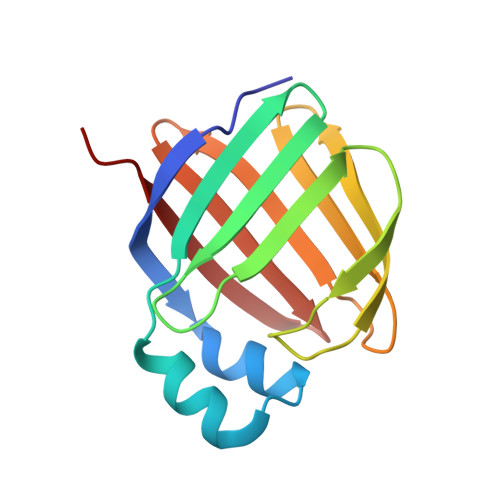Structural and molecular determinants affecting the interaction of retinol with human CRBP1.
Menozzi, I., Vallese, F., Polverini, E., Folli, C., Berni, R., Zanotti, G.(2017) J Struct Biol 197: 330-339
- PubMed: 28057518
- DOI: https://doi.org/10.1016/j.jsb.2016.12.012
- Primary Citation of Related Structures:
5LJB, 5LJC, 5LJD, 5LJE, 5LJG, 5LJH, 5LJK - PubMed Abstract:
Four cellular retinol-binding protein (CRBP) types (CRBP1,2,3,4) are encoded in the human genome. Here, we report on X-ray analyses of human apo- and holo-CRBP1, showing nearly identical structures, at variance with the results of a recent study on the same proteins containing a His-Tag, which appears to be responsible for a destabilizing effect on the apoprotein. The analysis of crystallographic B-factors for our structures indicates that the putative portal region, in particular α-helix-II, along with Arg58 and the E-F loop, is the most flexible part of both apo- and holoprotein, consistent with its role in ligand uptake and release. Fluorometric titrations of wild type and mutant forms of apo-CRBP1, coupled with X-ray analyses, provided insight into structural and molecular determinants for the interaction of retinol with CRBP1. An approximately stoichiometric binding of retinol to wild type apo-CRBP1 (Kd∼4.5nM), significantly lower binding affinity for both mutants Q108L (Kd∼65nM) and K40L (Kd∼70nM) and very low binding affinity for the double mutant Q108L/K40L (Kd∼250nM) were determined, respectively. Overall, our data indicate that the extensive apolar interactions between the ligand and hydrophobic residues lining the retinol binding cavity are sufficient to keep it in its position bound to CRBP1. However, polar interactions of the retinol hydroxyl end group with Gln108 and Lys40 play a key role to induce a high binding affinity and specificity for the interaction.
Organizational Affiliation:
Department of Life Sciences, University of Parma, Parco Area delle Scienze 23/A, 43124 Parma, Italy; Department of Physics and Earth Sciences, University of Parma, Parco Area delle Scienze 23/A, 43124 Parma, Italy.















